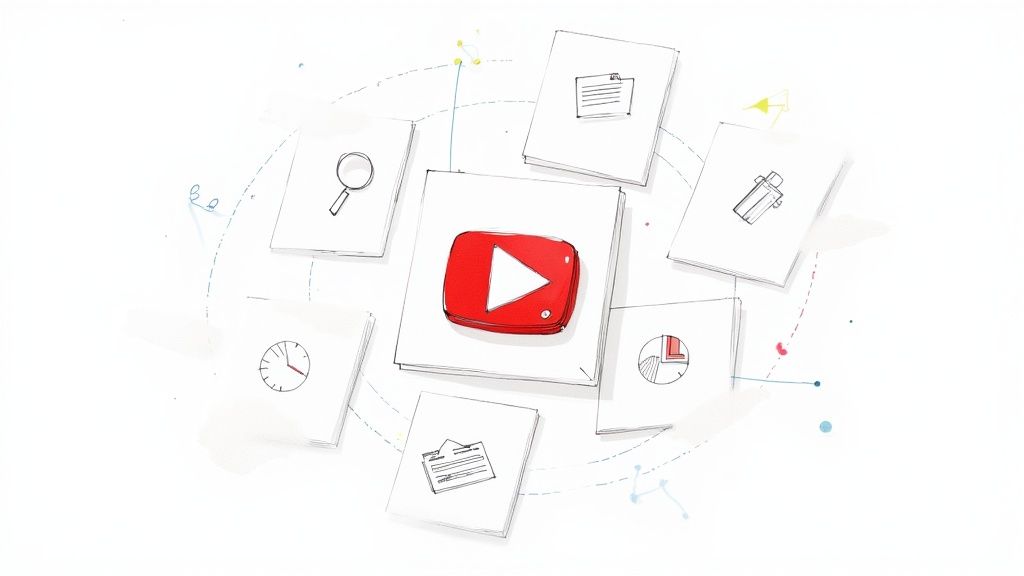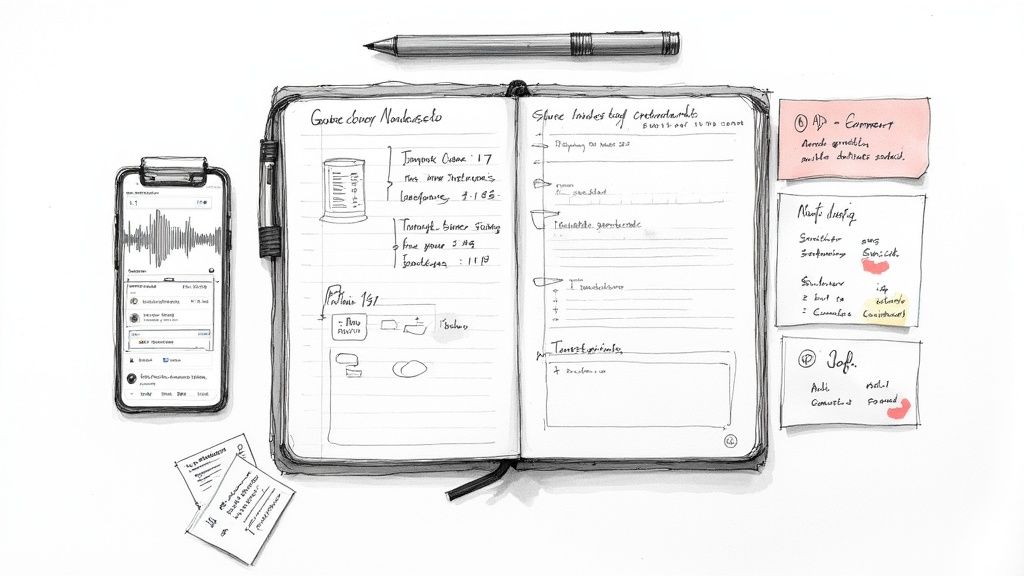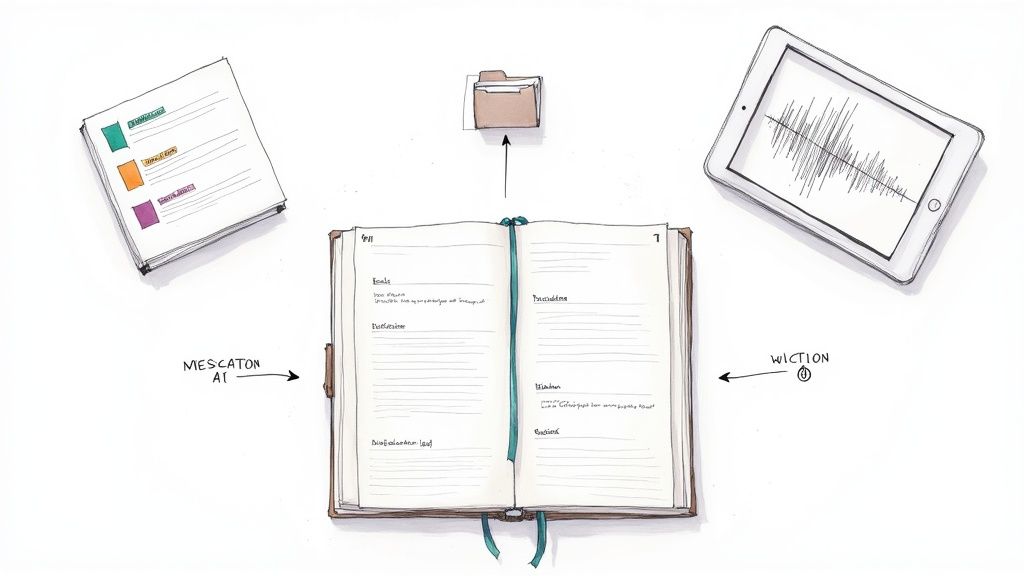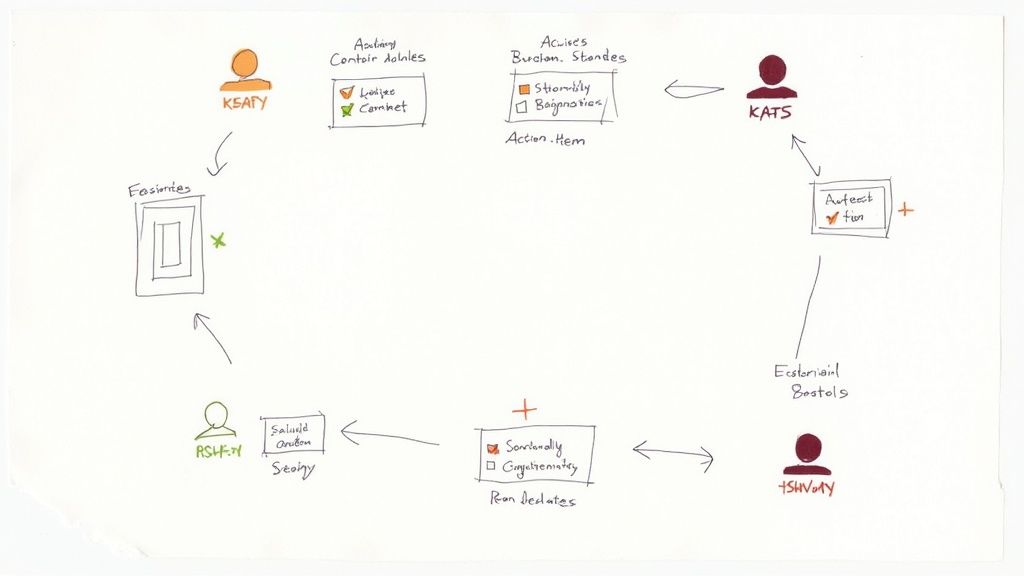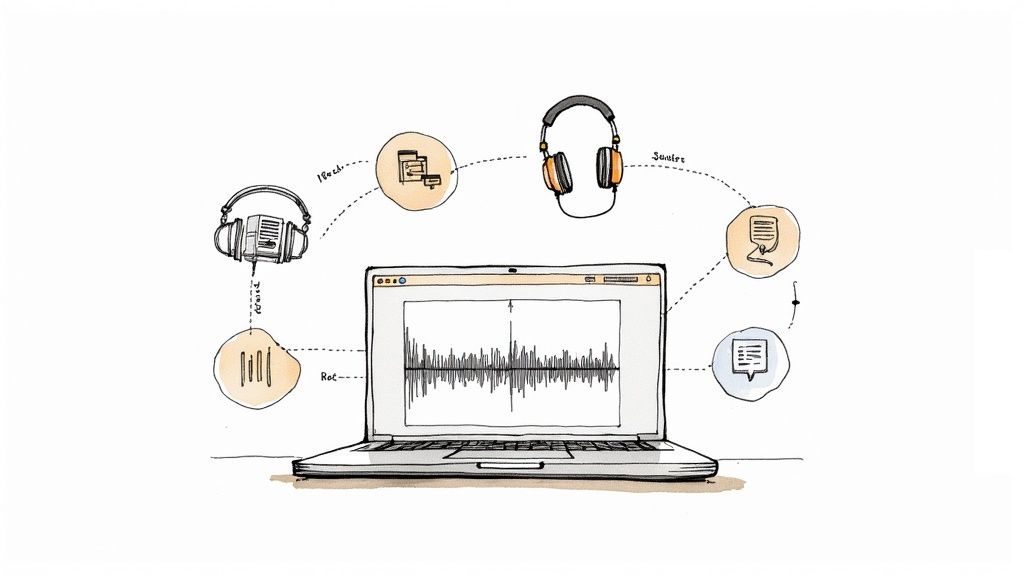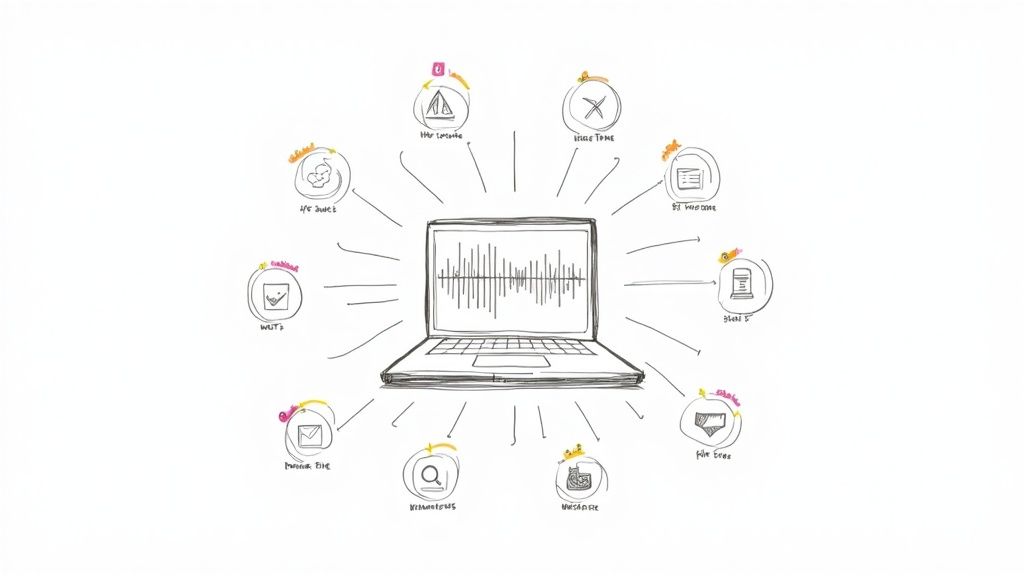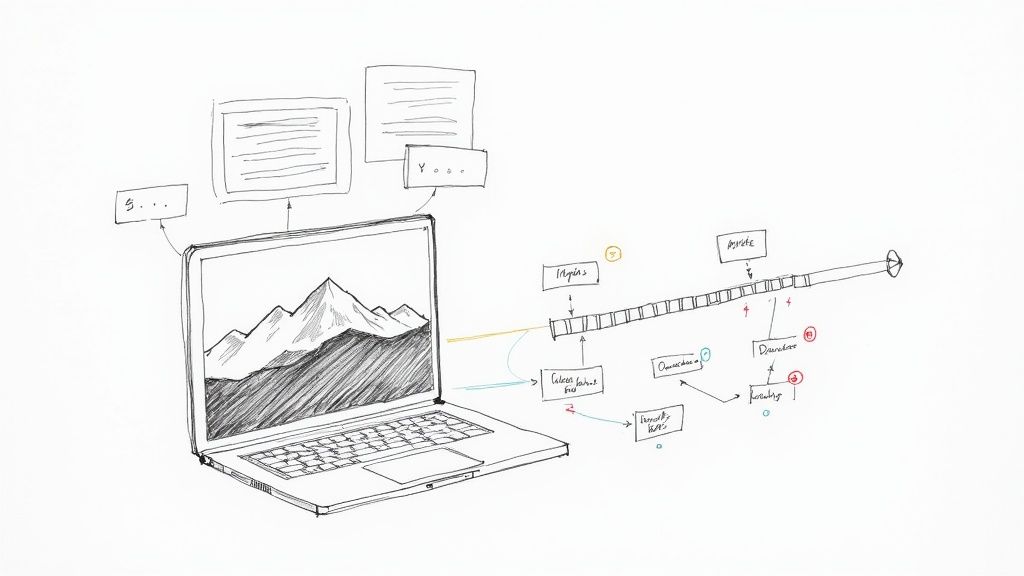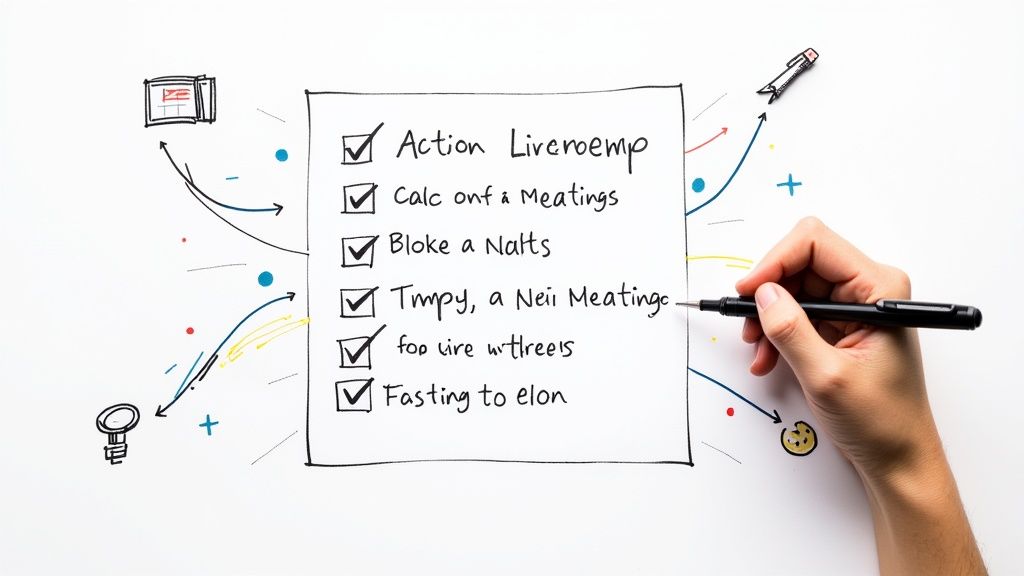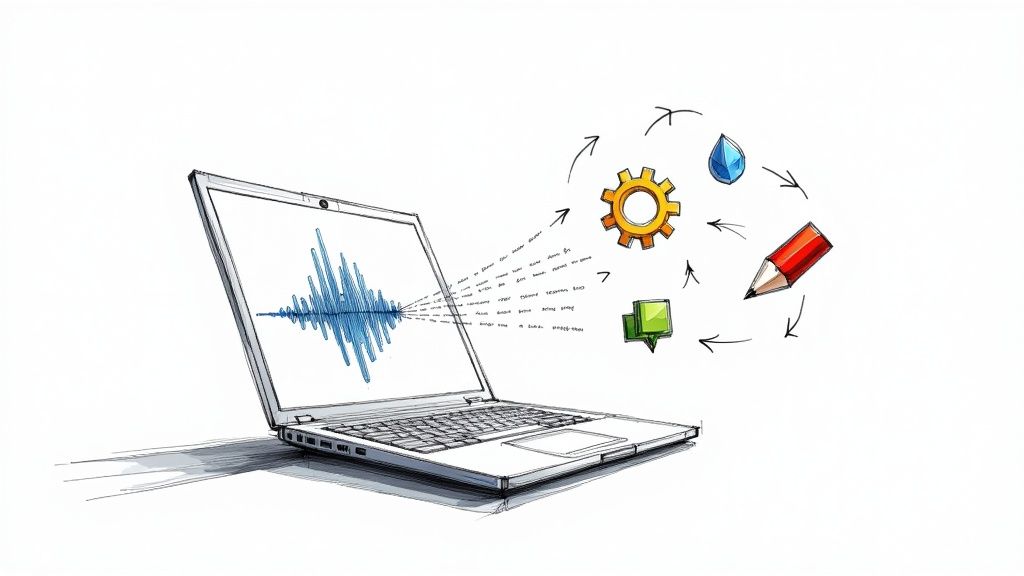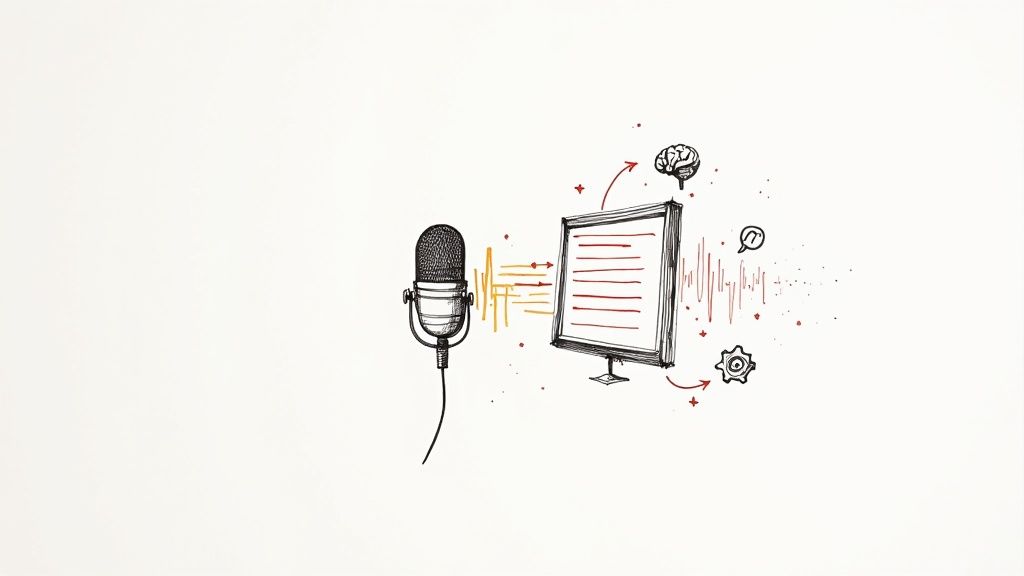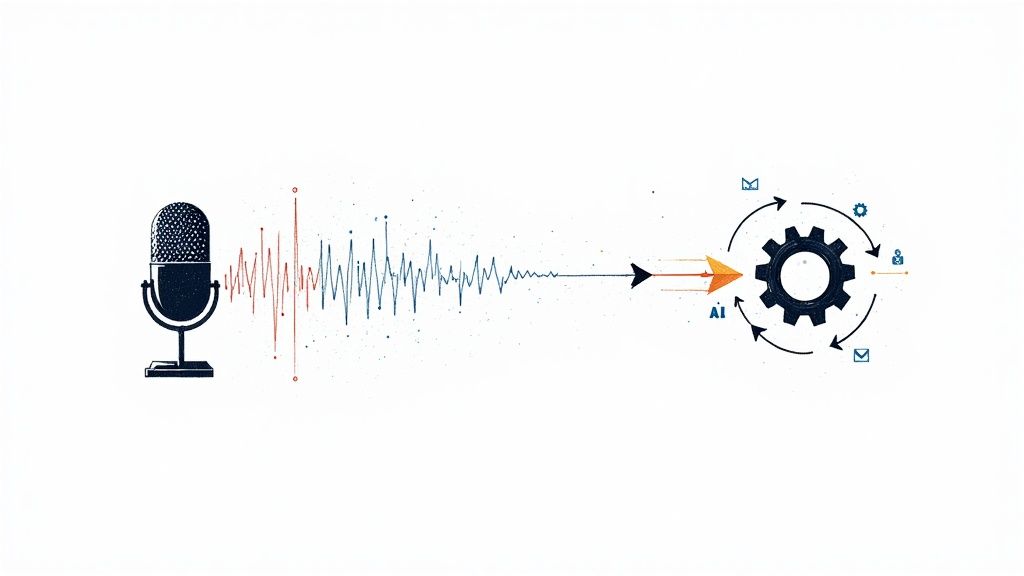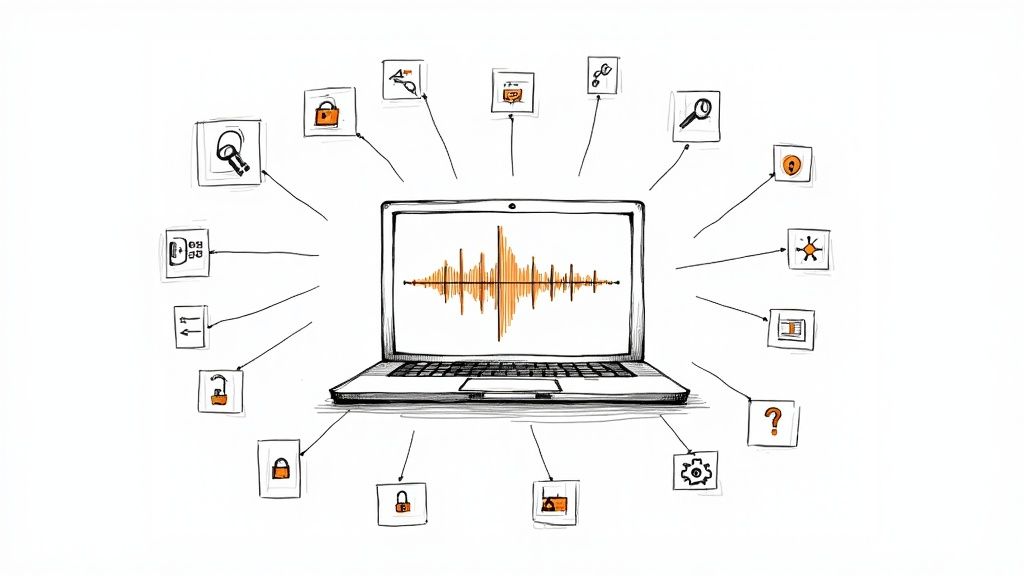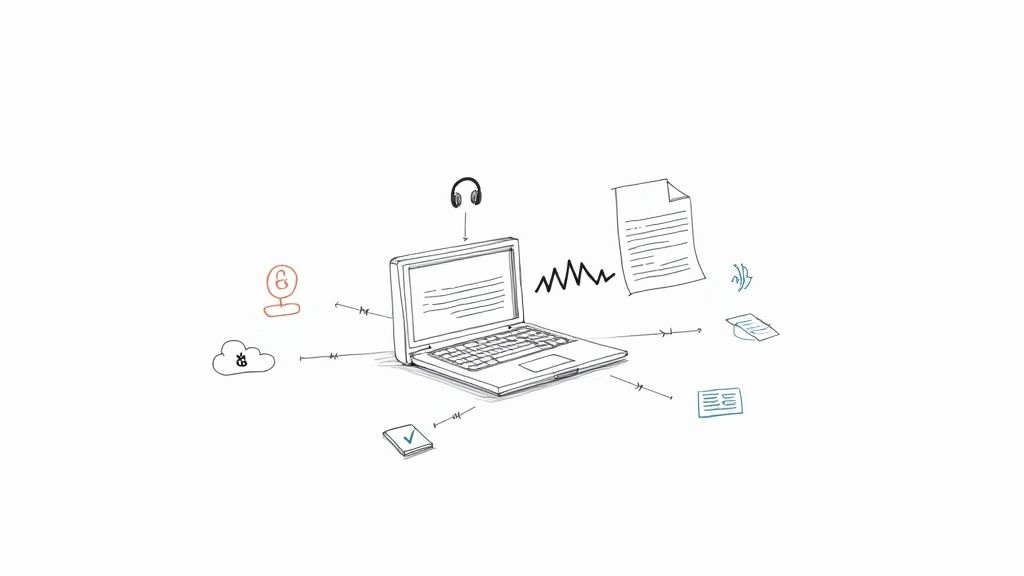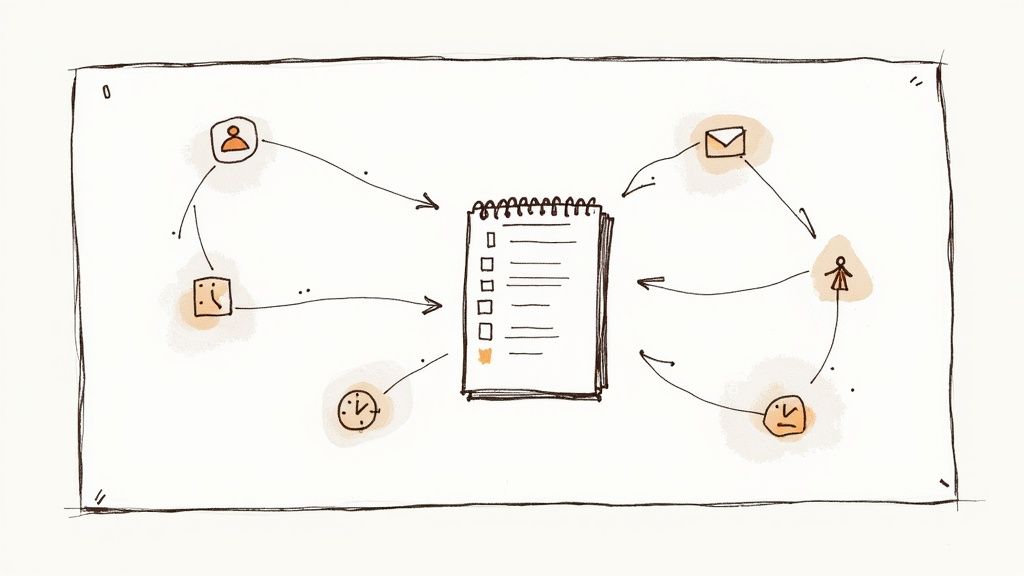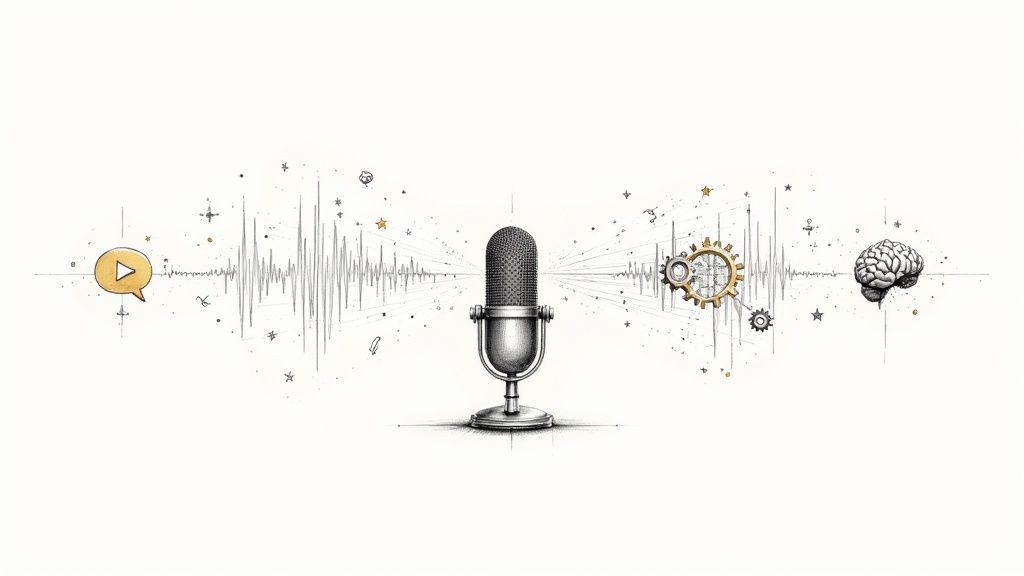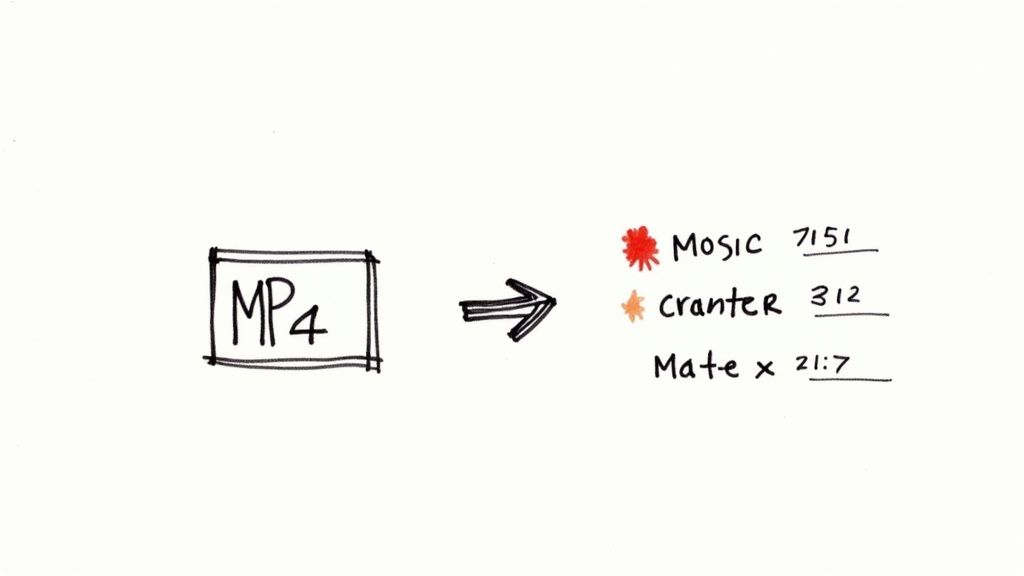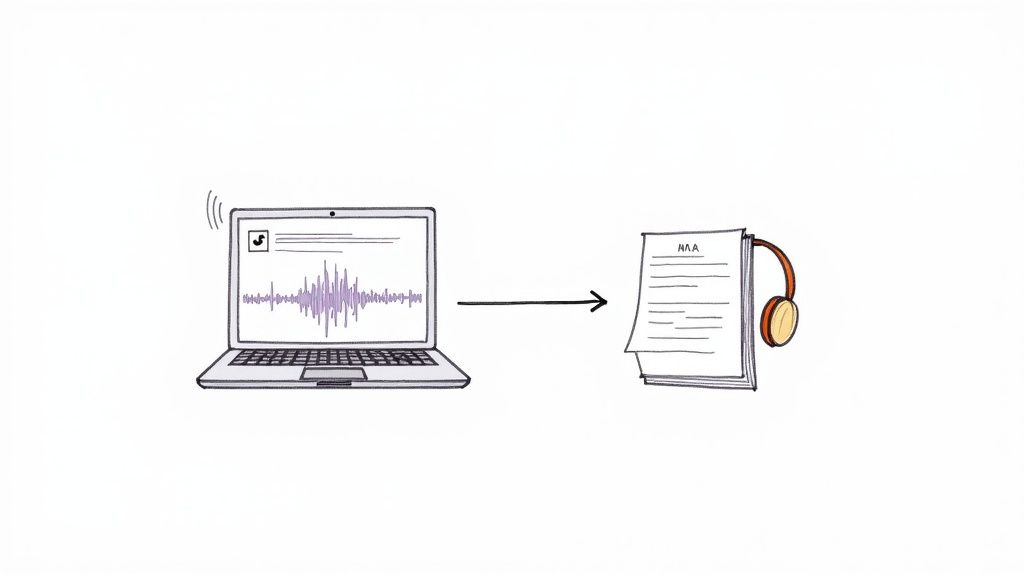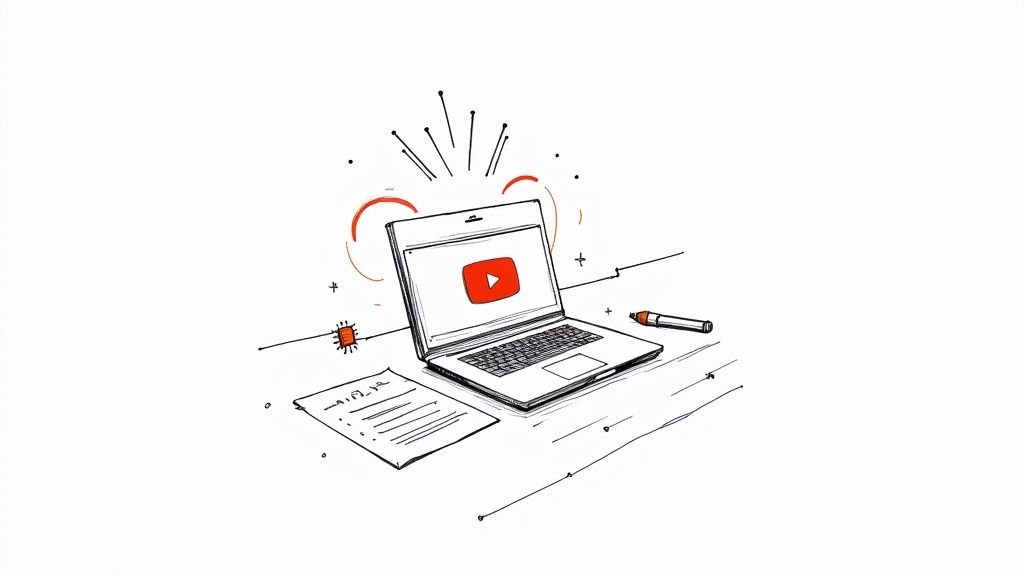
Your Practical Guide to AI Podcast Summarizers
Ever feel like your podcast queue is a bottomless pit? You've got dozens of episodes saved, all packed with valuable insights, but finding the time to listen is a whole other story. I've been there, and it's exactly why I started using an AI podcast summarizer.
Think of it as a smart assistant that listens to long-form audio for you, then hands you a concise, readable summary of all the important stuff. You get the key takeaways without having to dedicate hours of your day. It’s been a genuine game-changer for how I consume content.
Are You Tired of Information Overload? Here’s How to Fix It
That feeling of being swamped by your "must-listen" list is a real problem. From my experience, an AI podcast summarizer is the most effective solution, turning a time-consuming chore into a surprisingly efficient way to absorb knowledge.
This technology essentially acts as your personal content filter. It intelligently sifts through hours of conversation, identifies the most important points, and presents them to you. Instead of blocking out an hour for a single episode, you can understand its core message in just a few minutes of reading.
Reclaiming Your Time and Staying Informed
The biggest benefit I've found is simple: you get your time back. It's a game-changer for anyone trying to stay informed.
- Students can turn lecture podcasts into tidy study notes, zeroing in on key concepts without having to scrub through the entire recording again.
- Professionals can keep a pulse on industry trends by reviewing highlights from multiple shows in the time it used to take to listen to just one.
- Content creators can quickly pinpoint the best moments from their own episodes to create blog posts, social media clips, or newsletter highlights.
At its core, an AI podcast summarizer is more than just a convenience; it's a productivity tool designed for a world overflowing with audio content. It helps you learn faster, stay current, and make better use of your time.
This shift in how we consume content is happening inside a massive, growing industry. The global podcasting market is on a tear, projected to jump from USD 30.72 billion in 2024 to an incredible USD 131.13 billion by 2030. You can read the full research about podcast market growth to see just how much technology is fueling this expansion.
This is an image of the Podcast Index logo, a project dedicated to preserving and enhancing the open, independent podcasting ecosystem.

Initiatives like the Podcast Index underscore just how vast the world of audio has become—and how essential AI tools are for making it all accessible and searchable.
How Does an AI Podcast Summarizer Actually Work?
Ever wondered what's going on under the hood when you feed an AI podcast summarizer an hour-long episode and get back a handful of key takeaways? It’s not magic, but it is a clever, three-stage process where different AI technologies team up. Understanding this workflow helps you see exactly how it works and trust the results it produces.
The whole thing starts the moment you upload your audio file or paste in a link. The AI's first job is to turn all that spoken audio into text it can actually read and analyze. This initial step is the foundation for everything that follows.
Step 1: Transcription with Automatic Speech Recognition (ASR)
The process kicks off with Automatic Speech Recognition (ASR). The easiest way to think of ASR is as a super-fast, highly-trained digital stenographer. Its only job is to listen to the podcast audio and carefully write down every single word that’s said. Modern ASR is incredibly good at this, capable of telling different speakers apart, handling a wide range of accents, and even ignoring distracting background noise.
This transcription step is absolutely critical. The quality of the final summary lives or dies by how accurate this initial text is. If the ASR gets words or phrases wrong, the next steps will be working with bad information. For a closer look at this technology, check out our guide on how audio to text AI really works.
Step 2: Understanding with Natural Language Processing (NLP)
Once the audio has been turned into a full text transcript, the second piece of technology takes over: Natural Language Processing (NLP). If ASR figures out what was said, NLP figures out what it all means. This is where the real smarts of an AI podcast summarizer come into play.
NLP algorithms scan the entire transcript to grasp context, pull out the main themes, and see how different ideas connect. It’s like having an expert researcher read through the text, highlighting the most important sentences and figuring out which arguments are central to the discussion. It doesn't just see a wall of words; it understands the intent and structure behind them.
This analytical stage is what separates a simple transcript from a useful summary. NLP is designed to find the signal in the noise, ensuring that the final output focuses on the core message rather than just random sentences.
The AI in podcasting market is projected to explode from USD 2.2 billion in 2023 to almost USD 26.6 billion by 2033. This incredible growth shows just how vital tools like ASR and NLP are becoming for both creators and listeners.
The diagram below shows how these technologies work one after another to create a summary.
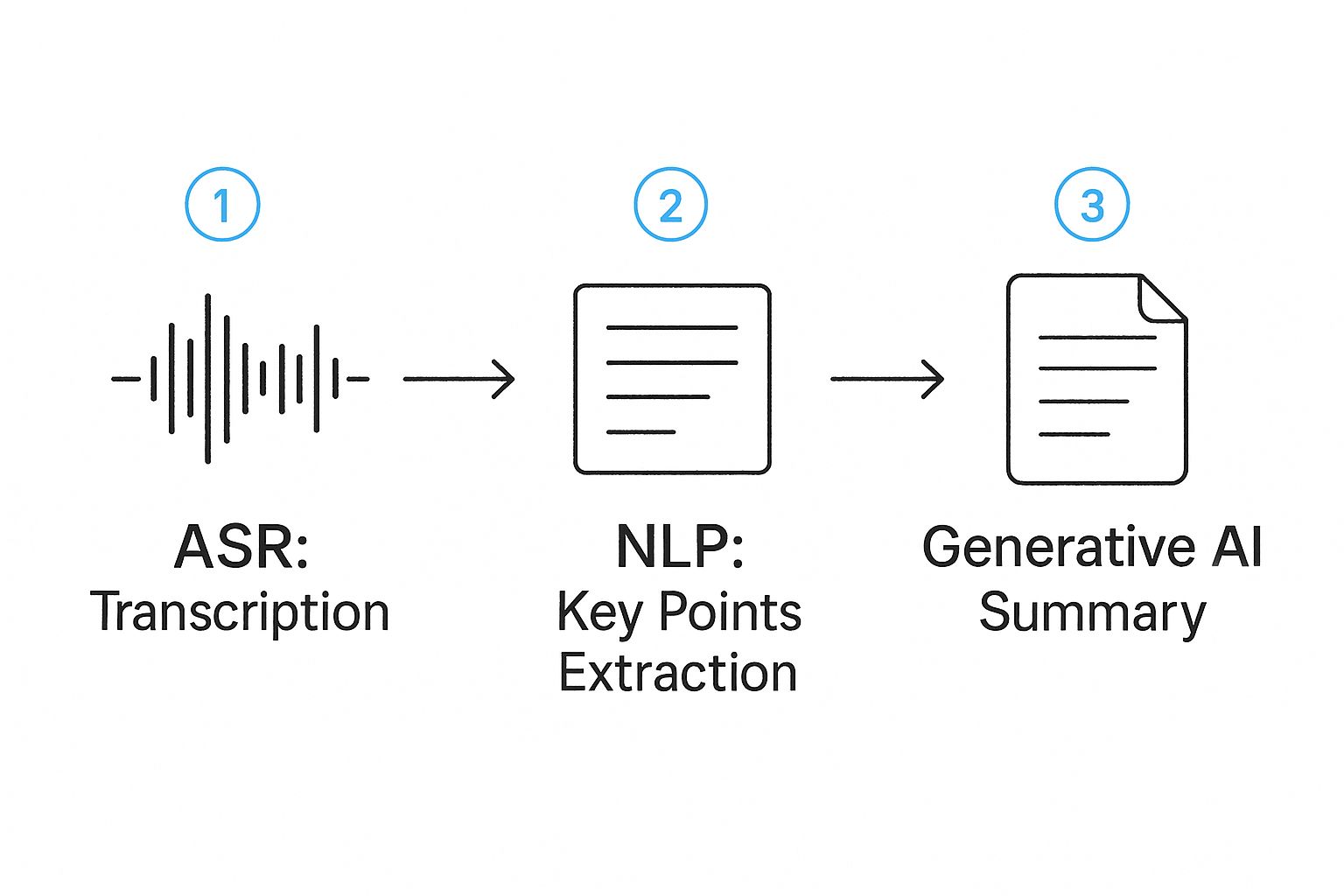
As you can see, it’s a clear progression from raw audio to a polished, easy-to-read summary, with specialized AI handling each part of the job.
Step 3: Creation with Generative AI
With the key points and main ideas identified by NLP, the final piece of the puzzle is generative AI. This is the tech that actually writes the summary you read. It takes all the highlighted information and crafts it into a brand new, coherent text.
Instead of just cutting and pasting sentences from the transcript, generative AI rephrases and restructures the concepts so they flow logically. This makes sure the summary is not only accurate but also genuinely easy to read. It can even create different types of summaries depending on what you need:
- Bulleted Lists: Perfect for getting the key takeaways at a glance.
- Concise Paragraphs: Gives you a more narrative-style overview.
- Actionable Items: Pulls out any specific tasks or next steps discussed.
By the time this three-part process—transcribe, analyze, and generate—is complete, you get a polished summary that captures the heart of the podcast. You save a ton of time and stay perfectly in the loop.
What Features Should You Look For in a Summarizer?

So, you get the idea behind an AI podcast summarizer. Now for the tricky part: how do you pick the right one? With so many tools on the market, it’s easy to get lost in a sea of marketing claims that all start to sound the same. The key is to look past the buzzwords and focus on the features that will actually save you time and deliver real value.
Based on my own testing, a basic summarizer might give you a quick glimpse of a podcast's content, but a truly great one provides the deep, actionable insights you need to get serious work done. Let's dig into the non-negotiable features that separate the good from the great.
Must-Have #1: High-Accuracy Transcription
Before an AI can summarize anything, it has to convert the audio into text. The accuracy of this first step is absolutely critical. If the transcription is full of mistakes, the summary will be a confusing mess. It’s the classic "garbage in, garbage out" scenario.
A top-tier AI podcast summarizer should deliver transcription accuracy of 95% or higher. This high benchmark ensures the AI is working with a faithful representation of the original conversation, which leads to reliable, contextually sound summaries. Everything else is built on this foundation, so if the transcription is shaky, the whole thing falls apart. If you want to see what high-quality transcription looks like, check out some of the best free audio to text converters to get a feel for the technology.
Must-Have #2: Speaker Identification (Diarization)
Ever tried reading a transcript from an interview with multiple people and had no clue who was talking? It’s a frustrating experience. That's where speaker identification (also known as diarization) comes in. This feature automatically tags and separates the dialogue for each person.
For anyone working with interviews, panel discussions, or co-hosted shows, this isn't just a "nice-to-have"—it's a game-changer. It transforms a jumbled block of text into a clean, easy-to-read script. You can instantly follow the back-and-forth, attribute quotes correctly, and pinpoint who shared a specific insight.
A summary that can distinguish between the host's questions and the expert's answers provides a level of clarity that is impossible to achieve otherwise. It helps you quickly find the "who" behind the "what."
Must-Have #3: Clickable Timestamps
Another must-have feature is timestamps. These are little markers embedded in the text that link a word or sentence directly to its spot in the original audio file. This seemingly simple feature serves two incredibly important functions.
First, it makes fact-checking a breeze. If a point in the summary catches your eye and you want to hear it for yourself, just click the timestamp. You’ll jump straight to that moment in the audio, saving you from the tedious task of manually scrubbing through the timeline.
Second, timestamps are a content creator’s secret weapon. They let you instantly find the most powerful soundbites for creating social media clips, audiograms, or pull quotes. It’s the fastest way to find those golden nuggets and repurpose your podcast into shareable content.
A Quick Checklist for Choosing Your Tool
To make your decision easier, here is a clear checklist of what to look for. Not all tools are built the same, and these core features are what truly make a difference in your day-to-day workflow.
FeatureWhy It MattersWhat to Look ForHigh-Accuracy TranscriptionThe summary's quality is entirely dependent on an accurate text foundation.Tools that promise a high accuracy rate (95% or more) and can handle different accents and background noise.Speaker IdentificationMakes multi-speaker podcasts easy to follow and allows for proper attribution of quotes.The ability to automatically label speakers (e.g., Speaker 1, Speaker 2) or even let you assign custom names.Clickable TimestampsLets you jump directly to the source audio for context and makes creating clips effortless.Interactive, word-level or sentence-level timestamps that are clearly linked to the media player.Flexible Summary FormatsAllows you to get the right kind of summary for whatever you need at the moment.Options to generate bullet points, short paragraphs, detailed summaries, or even specific action items.
Ultimately, the best AI podcast summarizer is the one that has the features you'll actually use. By focusing on these core functionalities, you can cut through the noise and find a tool that genuinely enhances your productivity.
How Can You Use an AI Podcast Summarizer in Real Life?

It’s one thing to talk about the tech, but the real magic happens when you see what an AI podcast summarizer can do in the real world. These aren't just tools for catching up on your queue; they’re workhorses for learning, market research, and content creation. When you plug summarization into your daily workflows, you start getting back time you never thought you had.
So, let's step away from theory and look at three practical examples of how people are using this technology to get more done with less effort.
For the Diligent Student: Turning Lectures Into Study Guides
Picture a college student buried under three different lecture series, all delivered as podcasts. Each episode is an hour long, and finals are breathing down their neck. The old way—re-listening to hours of audio just to find a few key concepts—is a massive time sink.
This is a perfect job for an AI podcast summarizer. The student can feed the audio files into the tool and get back a structured summary in minutes. It essentially turns a dense, rambling lecture into a perfectly organized study aid.
- Key Concept Extraction: The summary pulls out the core theories, definitions, and main arguments, giving you a bird's-eye view of what actually matters.
- Timestamped References: If a point in the summary seems fuzzy, you can just click the timestamp and jump right to that specific moment in the lecture for the full context.
- Searchable Text: Forget scrubbing aimlessly through an audio file. Now you can just search the transcript for a specific keyword the professor mentioned.
This whole process shifts learning from passive listening to an active, engaged experience. The summary becomes a living study guide you can search, review, and build on with your own notes, saving countless hours of prep time.
For the Savvy Marketer: Tracking Industry Trends
Now, let's think about a marketer who needs to stay on top of a fast-moving industry. There are a dozen must-listen podcasts dropping new episodes every week, covering everything from competitor moves to emerging tech. That can easily add up to 10+ hours of audio a week, which is just not realistic for anyone.
Here, an AI podcast summarizer becomes a secret weapon for competitive intelligence. The marketer can run the latest episodes through the tool and get the critical highlights without having to listen to all the fluff.
- Competitor Mentions: Instantly flag when a competitor’s new product or campaign gets a mention.
- Trend Spotting: The AI is great at picking up on themes that pop up across multiple podcasts, signaling a new trend is taking hold.
- Strategic Insights: Summaries can pull out expert predictions and sharp opinions, arming the marketer with solid data for their next strategy meeting.
Suddenly, a week's worth of industry chatter gets boiled down to a one-hour read. The marketer stays informed, spots opportunities first, and can react to market shifts while their competitors are still slogging through their podcast backlog.
For the Creative Podcaster: Repurposing Audio Content
Finally, imagine a podcaster who just wrapped up a great one-hour interview. That audio file is a goldmine, but chopping it up into different content formats by hand is a soul-crushing task. An AI podcast summarizer completely changes the game for content repurposing.
Turning that audio into structured text is where the real leverage is. The global podcast audience is huge and getting bigger, jumping from 507 million listeners in 2023 to an estimated 547 million in 2024. To tap into that growth, creators need to be efficient. You can read more about these evolving podcast listener trends and see why serving content in multiple formats is so important.
Here's how a creator's workflow might look:
- Generate a Full Transcript and Summary: First, they get a clean transcript with speaker labels and a tight summary of the episode’s main takeaways.
- Create a Blog Post: The summary and key transcript sections become the perfect foundation for a blog post. This helps with SEO and reaches people who'd rather read than listen.
- Craft Social Media Updates: The best pull-quotes are already identified in the summary, ready to be turned into engaging posts for Twitter, LinkedIn, or Instagram.
- Write a Newsletter: The bullet-point highlights from the summary can be dropped straight into a weekly newsletter, giving subscribers a quick, valuable snapshot of the new episode.
By using a tool like Whisper AI, a creator can take a single recording and spin it into a week's worth of content for different channels. It’s all about maximizing your reach and impact without burning yourself out.
Your Step-by-Step Guide to Summarizing a Podcast
https://www.youtube.com/embed/Mf9F6j_RWpI
Alright, now that you see what these tools can do, you’re probably eager to try one out. The good news is that getting started with a modern AI podcast summarizer is incredibly simple. Let's walk through the whole process, from uploading your audio to getting a polished summary you can actually use.
Think of it like making a good cup of coffee. You start with the beans (your podcast audio), run it through the machine (the AI tool), and you end up with a perfect shot of espresso (a concise, powerful summary). By the time we're done here, you'll be able to summarize any episode with confidence.
Step 1: Prepare Your Podcast Audio or Link
First things first, you need to get your podcast into the system. You'll almost always have two main options: upload an audio file directly from your computer, or just paste in a link to the episode on a platform like YouTube or Spotify.
From my experience, using a link is usually quicker and a lot less hassle, especially for episodes that are already live. Just make sure the source audio is clear—better sound quality means a more accurate transcript, which is the foundation for a great summary.
Step 2: Initiate the Transcription and Summarization
With your audio loaded, it’s time to let the AI do its thing. You'll see a button that says something like "Transcribe" or "Summarize." One click is all it takes to set the whole process in motion.
This is the part where you can grab a coffee and relax for a minute. The tool is now converting all of that speech into text, analyzing the key points, and crafting the summary. Depending on how long the episode is, this can take a few minutes.
Pro Tip: If the tool gives you choices, think about what you need the summary for. A quick list of takeaways? Choose the "bullet points" option. A more detailed, narrative-style overview? Go for a "paragraph" summary.
Step 3: Review and Refine the AI-Generated Output
Once the AI is finished, you’ll get the results. This typically includes a full transcript—often with speaker labels and timestamps—and the summary itself. The first thing you should always do is give it a quick scan.
Let's be real: no AI is perfect. You might spot little mistakes, especially with unusual names, company-specific jargon, or technical terms. Your role here is to be the final editor, cleaning things up and making sure everything reads smoothly. This is also your chance to put your own spin on it.
For instance, you can:
- Fix transcription errors: Correct any misspelled names or specialized words.
- Adjust the summary's focus: Maybe the AI missed a key point you want to highlight, or included something that isn't relevant to your audience.
- Tweak the tone: Rewrite a few sentences to make the summary sound more like you.
This "human-in-the-loop" step is what turns a good AI summary into a great one. The initial text is created through a fascinating process, which you can read more about in our guide to automatic transcribe software.
Step 4: Ask Follow-Up Questions to Deepen Insights
Here's where things get really powerful. Many of the best tools don't just give you a summary and call it a day; they let you interact with it. Instead of just taking the initial output, you can ask follow-up questions to dig deeper.
This turns the summarizer into more of an interactive research assistant. You could ask things like:
- "What were the top three actionable tips mentioned in this episode?"
- "Create a list of all the books the guest recommended."
- "Explain the main argument against the host's primary point."
This is a game-changer. It lets you pull out the exact information you need without having to sift through the entire transcript yourself.
Step 5: Export and Use Your Summary
The last step is getting your polished summary out of the tool and into the wild. A good AI podcast summarizer will let you export your work in different formats, like PDF, Word, or plain text, so you can easily plug it into whatever you're doing.
Now you're ready to go. Drop the key points into your newsletter, use the text to outline a new blog post, or just save the summary for your own notes. You’ve just turned an hour-long audio file into a valuable, easy-to-digest asset—and it only took you a few minutes.
What's Next for AI in Audio Content?
An AI podcast summarizer is an incredibly useful tool right now, but honestly, it’s just the tip of the iceberg. The technology that powers these summaries is setting the stage for a future where audio content is completely interactive, searchable, and personalized in ways that still feel a bit like science fiction.
Think of today's summarizers as the solid foundation. The next wave of innovation is already being built on top of them, with a clear goal: making massive audio libraries as easy to sift through as a simple text document. This isn't just a minor upgrade; it's a fundamental shift in how we find and connect with spoken-word content.
Beyond Summaries to True Audio Intelligence
The new tech on the horizon is all about making audio more dynamic and accessible. We’re moving past just squishing an hour-long episode into a few paragraphs and toward unlocking the actual knowledge trapped inside all those audio files.
Imagine a world with tools that could do this:
- Semantic Search: Forget just searching for keywords. You could ask a natural question like, "Where did the guest on this show talk about their Q3 financial predictions?" The AI would then find the exact moment, even if you have thousands of episodes to sort through.
- Automated Content Creation: The AI could listen to an episode and automatically generate detailed show notes, create timestamps for chapters, and even draft a few promotional social media posts from that single audio file.
- Personalized Audio Feeds: Future systems will get to know your listening habits and create custom audio "mixtapes" for you, pulling relevant segments from different podcasts that match what you're interested in that day.
This future isn't about replacing human creativity—it's about amplifying it. It's about building smart systems that handle the grunt work of organizing and finding information, which frees up creators to focus on making amazing content and helps listeners find it without any friction.
One of the most exciting developments is what’s happening with real-time translation. Soon, an AI podcast summarizer won't just condense an episode; it'll be able to translate it into dozens of languages on the fly, making shows instantly available to a global audience. This is the kind of technology that breaks down language barriers for good, making knowledge and entertainment accessible to everyone, everywhere. The humble summarizer is our first step into this incredibly connected future of audio.
Frequently Asked Questions About AI Podcast Summarizers
If you're still curious about how AI podcast summarizers work, you're not alone. Let's tackle some of the most common questions people have when they first start exploring these tools.
How Accurate Are AI-Generated Summaries?
This is usually the first thing people ask, and it’s a great question. The quality of any summary hinges almost entirely on the accuracy of the initial transcript. Think of it like building a house—if the foundation is shaky, the rest of the structure will be too.
Top-tier tools that can hit 95% or higher transcription accuracy will give you summaries that are not just reliable but also understand the context of the conversation. On the flip side, if you feed it audio with a lot of background noise or speakers who are hard to understand, you can expect the accuracy to drop. It's always smart to give the final summary a quick once-over, just to be sure.
What Does an AI Summarizer Cost?
Pricing for an AI podcast summarizer is all over the map. You can find some tools with a free plan, which is perfect for trying things out or for someone who only needs a summary once in a while.
Most paid plans are subscription-based. You’ll typically pay a monthly fee based on how many hours of audio you need to process. These plans can run anywhere from $10 to $50 a month, with the higher-end options usually including features like identifying different speakers or offering more ways to export your content.
When you're looking at the price tag, don't forget to factor in the time you're getting back. If a tool saves you a few hours of manual work every month, it often pays for itself pretty quickly.
Is My Audio Content Kept Private and Secure?
Data privacy is a huge deal, and it should be. Any reputable summarizer tool takes security seriously. They process your files on secure servers and should have a crystal-clear policy that they won't use your data to train their AI models unless you explicitly say it's okay.
Before you commit, take a minute to read the provider’s privacy policy. Make sure they comply with standards like GDPR and CCPA. Your content belongs to you, and it should stay that way.
Ready to stop drowning in audio and start pulling out the key insights? Whisper AI gives you instant, accurate transcripts and sharp summaries for your podcasts, interviews, and meetings. Get started for free today and discover how simple it is to turn hours of talk into actionable intelligence.
